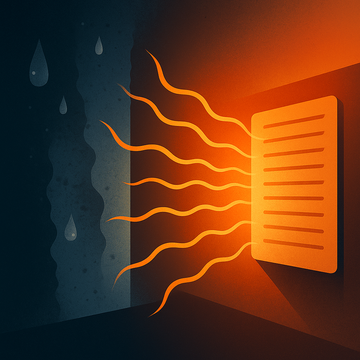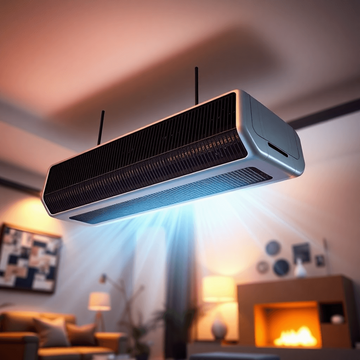10 Surprising Ways Infrared Heating Reduces Carbon Emissions
Imagine a world where staying warm doesn't come at the cost of our planet's health. With infrared heating, that's not just a dream—it's becoming a reality. You might be surprised to learn that this technology can slash your carbon emissions in ways you never thought possible. From its energy efficiency to its compatibility with renewable sources, infrared heating is revolutionising how we think about home and industrial heating.
Ready to discover how you can reduce your carbon footprint while staying toasty? Let's dive into 10 surprising ways infrared heating is making a difference in the battle against carbon emissions.
Energy Efficiency
Infrared heating stands out as a game-changer in the quest for energy efficiency and carbon emission reduction. Unlike traditional heating systems that warm the air, infrared heaters directly heat objects and people in a room. This fundamental difference is key to understanding its efficiency. When you use infrared heating, you're not wasting energy on heating empty spaces or air that quickly escapes. Instead, the infrared waves travel through the air without losing energy and are absorbed by solid surfaces, including your body.
Here's how infrared heating minimises energy waste:
-
Direct heat transfer: Infrared rays heat objects and people directly, eliminating the middleman (air) and reducing energy loss.
-
Instant warmth: You feel the heat immediately, reducing the time the system needs to run.
-
Even heat distribution: Infrared heating provides consistent warmth throughout the space, eliminating cold spots and the need for overheating.
-
No heat loss through ventilation: Since it doesn't heat the air, you don't lose warmth when opening doors or windows.
You'll find that infrared heating systems are incredibly efficient, often converting over 90% of the electricity they use into heat. This high conversion rate means less energy is wasted in the heating process, directly translating to lower carbon emissions.
Moreover, you can target your heating more precisely with infrared technology. Instead of heating an entire house or building, you can focus on heating specific areas or rooms that are in use. This targeted approach significantly reduces overall energy consumption and, consequently, your carbon footprint.
Infrared heating also works synergistically with your home's insulation. Since it heats solid objects, the warmth is retained in walls, floors, and furniture even after the heater is turned off. This residual heat continues to warm the space, reducing the frequency and duration of heating cycles.
By choosing infrared heating, you're not just opting for a more comfortable heating solution; you're making a conscious decision to minimise energy waste and contribute to carbon emission reduction. As you explore ways to make your home or business more eco-friendly, consider how infrared heating can play a crucial role in your energy efficiency strategy.
Lower emissions often go hand in hand with lower energy use, which we explore in how much infrared heating costs to run in the UK.
Targeted Heating for Reduced Energy Consumption
Zone heating capabilities
Infrared heating allows you to take control of your home's energy consumption like never before. With its zone heating capabilities, you can precisely target the areas you want to warm, reducing unnecessary energy use in unoccupied spaces. This targeted approach means you're not wasting energy heating empty rooms or rarely used areas of your home.
By focusing the heat where it's needed most, you can significantly reduce your overall energy consumption. For example, you can keep your living room cosy while maintaining a cooler temperature in bedrooms during the day. This flexibility allows you to create personalised comfort zones without overheating the entire house.
Precision temperature control
One of the most impressive features of infrared heating is its ability to provide precise temperature control. Unlike traditional heating systems that rely on warming the air, infrared heaters directly warm objects and people in the room. This means you can achieve your desired comfort level more quickly and maintain it more efficiently.
With infrared heating, you can:
-
Set different temperatures for different rooms
-
Adjust heat levels based on occupancy
-
Program heating schedules to match your daily routine
This level of control allows you to optimise your energy use, ensuring that you're only using the exact amount of heat needed at any given time. By avoiding temperature fluctuations and overheating, you're not just improving comfort but also reducing your carbon footprint.
Eliminating heat loss in unoccupied spaces
One of the biggest culprits in energy waste is heating unoccupied spaces. Traditional heating systems often struggle with this, as they heat entire buildings or floors regardless of which rooms are in use. Infrared heating solves this problem by allowing you to completely turn off heat in unused areas.
With infrared heating, you can:
-
Instantly switch off heating in empty rooms
-
Avoid wasting energy on rarely used spaces like guest rooms or storage areas
-
Quickly warm up a room when needed, without having to heat the entire house
This targeted approach to heating significantly reduces energy waste and, consequently, your carbon emissions. By only using energy where and when it's needed, you're making a substantial impact on your overall energy consumption.
Rapid Warmth: Less Time, Lower Emissions
Instant heat generation
When you switch on an infrared heater, you'll immediately feel the warmth. This instant heat generation means you're not wasting energy warming up the entire room before feeling comfortable.
The rapid response of infrared heating translates to significant energy savings. You'll find yourself using the heater for shorter periods, as the desired temperature is reached quickly. This efficiency directly contributes to lower carbon emissions, as less energy is consumed overall.
Reduced warm-up periods
Traditional heating systems often require a warm-up period, during which they consume energy without providing immediate comfort. With infrared heating, you'll notice:
-
Near instantaneous warmth
-
No need to preheat spaces
-
Ability to heat specific areas on demand
These reduced warm-up periods mean you're not burning fuel or using electricity unnecessarily. Every minute saved in heating translates to reduced carbon emissions, making infrared heating a more environmentally friendly option.
Eco-Friendly Manufacturing Process
Lower resource requirements
When it comes to manufacturing infrared heating systems, you'll be pleased to know that the process is significantly more eco-friendly compared to traditional heating methods. The production of infrared panels requires fewer raw materials, which translates to a reduced environmental impact right from the start.
Infrared heating panels are typically made from simple, readily available materials such as aluminium, steel, or ceramic. These materials are not only abundant but also easy to work with, requiring less energy intensive processes during manufacturing. You'll find that the streamlined design of infrared panels means fewer components are needed, further reducing the resource demand.
Moreover, the simplicity of infrared heating technology allows for a more efficient production line. You can expect:
-
Less water usage in the manufacturing process
-
Reduced energy consumption during production
-
Minimal waste generation, as most materials can be easily recycled
By choosing infrared heating, you're supporting a manufacturing process that aligns with sustainable practices and contributes to overall carbon emission reduction.
Reduced transportation emissions
Another surprising way infrared heating helps reduce carbon emissions is through its impact on transportation. You might not immediately think of transportation when considering heating systems, but it plays a significant role in the overall carbon footprint of a product.
Infrared panels are remarkably lightweight and compact compared to traditional heating systems. This means:
-
More units can be transported in a single shipment
-
Fewer trips are required to deliver the same heating capacity
-
Less fuel is consumed during transportation
You'll appreciate that this efficiency in transportation extends from the factory to your doorstep. Whether it's long-distance shipping or local delivery, the reduced weight and size of infrared panels contribute to lower fuel consumption and, consequently, decreased carbon emissions.
Longer lifespan
When you invest in infrared heating, you're not just choosing an efficient heating solution for today; you're making a decision that will positively impact carbon emissions for years to come. Infrared panels are known for their exceptional durability and longevity, which plays a crucial role in reducing the need for frequent replacements.
Here's why the longer lifespan of infrared heating systems matters for carbon emission reduction:
-
Fewer replacements mean less manufacturing over time
-
Reduced waste from discarded heating systems
-
Lower cumulative emissions from production and transportation
Infrared panels have no moving parts, which significantly reduces the risk of mechanical failures. You'll find that they require minimal maintenance, further extending their usable life. Many infrared heating systems can last 20 years or more with proper care, far outlasting traditional heating methods.
This longevity not only saves you money in the long run but also contributes to a substantial reduction in carbon emissions associated with the production, transportation, and disposal of heating systems. By choosing infrared heating, you're making a long-term commitment to reducing your carbon footprint.
Integration with Renewable Energy Sources
Compatibility with solar power
Infrared heating systems and solar panels are a match made in eco-heaven. Here's why:
-
Low power requirements: Infrared heaters consume less electricity compared to traditional heating systems, making them ideal for pairing with solar panels.
-
Direct current compatibility: Many infrared heating panels can operate on direct current (DC) power, which is what solar panels generate, reducing the need for power conversion.
-
Complementary peak times: Solar energy production often peaks during daylight hours, coinciding with when you're most likely to need heating in your home or office.
The integration of infrared heating with solar power offers numerous benefits for reducing your carbon footprint:
-
Energy independence: By combining these technologies, you can significantly reduce your reliance on the grid, potentially even achieving a net-zero energy home.
-
Cost savings: While the initial investment might be higher, the long-term savings on energy bills can be substantial.
-
Increased efficiency: Solar-powered infrared heating systems can operate at peak efficiency, as they're not subject to voltage fluctuations from the grid.
-
Scalability: You can start small and gradually expand your solar and infrared heating setup as your needs or budget allow.
To maximise the benefits of this integration, consider the following tips:
-
Size your solar system appropriately: Consult with a professional to ensure your solar panel array can adequately power your infrared heating needs.
-
Invest in energy storage: Battery systems can store excess solar energy for use during cloudy days or at night, ensuring consistent heating.
-
Use smart controls: Implement intelligent thermostats and energy management systems to optimize the use of solar power for your infrared heating.
-
Consider orientation: Properly position your infrared panels to complement the heat distribution from sunlight entering your home.
Smart Home Integration for Optimised Usage
AI-powered scheduling
Smart home integration takes infrared heating to the next level, significantly enhancing its ability to reduce carbon emissions. AI-powered scheduling is at the forefront of this revolution, allowing you to optimize your heating system's performance with minimal effort.
By leveraging machine learning algorithms, your infrared heating system can learn your daily routines and preferences. This means you no longer need to manually adjust your thermostat throughout the day. Instead, the AI predicts when you'll be home and ensures your space is comfortably warm upon your arrival, without wasting energy when you're away.
The benefits of AI-powered scheduling include:
-
Reduced energy waste: The system only heats when necessary, cutting down on unnecessary energy consumption.
-
Personalised comfort: It learns your preferred temperatures for different times of the day, ensuring optimal comfort.
-
Continuous optimisation: The AI constantly refines its predictions, becoming more accurate over time.
-
Cost savings: By reducing energy usage, you'll see a noticeable decrease in your heating bills.
Occupancy-based activation
Building on the intelligence of AI scheduling, occupancy-based activation takes energy efficiency a step further. This feature uses sensors to detect when you're present in a room and activates the infrared heating accordingly.
You'll appreciate how this system responds to unexpected changes in your routine. If you come home early or stay late at work, the heating adjusts automatically. This real-time responsiveness ensures that energy isn't wasted heating empty rooms, directly contributing to a reduction in carbon emissions.
Reduced Reliance on Fossil Fuels
Decreased natural gas consumption
You've likely heard about the environmental impact of fossil fuels, particularly natural gas. By adopting infrared heating, you can significantly reduce your reliance on this non-renewable energy source. Infrared heaters directly warm objects and people in a room, rather than heating the air, which means you'll use less energy overall. This efficiency translates to a decreased demand for natural gas, helping you lower your carbon footprint.
Consider these benefits of reducing natural gas consumption through infrared heating:
-
Lower greenhouse gas emissions
-
Reduced risk of gas leaks and associated safety hazards
-
Decreased dependence on volatile natural gas prices
-
Minimised environmental impact from gas extraction and transportation
By making the switch, you're not just saving money; you're actively contributing to a cleaner, more sustainable future.
Minimising coal-fired electricity demand
While you might not directly use coal for heating, many power grids still rely heavily on coal-fired power plants to generate electricity. By choosing infrared heating, you're indirectly contributing to a reduction in coal consumption. Infrared heaters are highly efficient, which means they require less electricity to operate compared to traditional heating systems.
Here's how infrared heating helps minimize coal-fired electricity demand:
-
Lower overall energy consumption reduces the strain on power grids
-
Decreased peak demand during cold months lessens the need for coal-fired backup power
-
Compatibility with renewable energy sources further reduces reliance on coal-generated electricity
Improved Building Insulation
Infrared heating works hand in hand with modern insulation techniques to create a powerful duo for energy efficiency. When you combine infrared heating with well-insulated spaces, you're creating an environment that retains heat more effectively and reduces the overall energy needed to maintain comfortable temperatures.
The combination of infrared heating and proper insulation significantly enhances your building's overall thermal efficiency. Here's how this synergy works to your advantage:
-
Reduced heat stratification: Infrared heating warms objects directly, creating a more even temperature distribution throughout the room.
-
Faster heat-up times: Well-insulated spaces retain heat better, allowing infrared heaters to warm the area more quickly.
-
Lower energy consumption: The improved efficiency means your heating system doesn't have to work as hard, reducing energy use and carbon emissions.
-
Improved comfort: The combination results in a more comfortable living or working environment with fewer cold spots.
Reducing heat loss through walls and windows
One of the most significant benefits of combining infrared heating with modern insulation is the dramatic reduction in heat loss through walls and windows. Traditional heating systems often struggle to maintain comfortable temperatures in poorly insulated spaces, leading to excessive energy consumption and higher carbon emissions.
When you use infrared heating in a well-insulated space, you're addressing heat loss on multiple fronts:
-
Radiant heat absorption: Infrared heating warms surfaces directly, which then radiate heat back into the room, reducing the temperature difference between indoor and outdoor environments.
-
Minimised convection losses: Since infrared heating doesn't rely on warming air, there's less heat lost through air leaks around windows and doors.
-
Reduced conduction: Well-insulated walls and windows act as a barrier to heat transfer, keeping the warmth generated by infrared heaters inside.
Industrial Applications: Large-Scale Impact
Warehouse heating solutions
As we delve into the industrial applications of infrared heating, it's clear that these systems have a significant impact on reducing carbon emissions, especially in large-scale settings. Warehouses, with their vast open spaces, present unique heating challenges that infrared technology is particularly well-suited to address.
Infrared heating offers several advantages for warehouse environments:
-
Targeted heating: Unlike traditional forced-air systems, infrared heaters direct heat precisely where it's needed, warming objects and people rather than the entire air volume.
-
Energy efficiency: By focusing heat where it's most beneficial, infrared systems can reduce energy consumption by up to 50% compared to conventional heating methods.
-
Rapid response: Infrared heaters provide almost instant warmth, allowing for quick temperature adjustments and minimizing energy waste during idle periods.
-
Zoning capabilities: Large warehouses can be divided into heating zones, ensuring that only occupied areas are heated, further reducing energy use and emissions.
Health and Comfort: Indirect Emission Reductions
Decreased need for air purification
When you opt for infrared heating, you're not just choosing a more energy-efficient option; you're also creating a healthier living environment. Unlike traditional heating systems that circulate air, infrared heating directly warms objects and people in the room. This unique approach significantly reduces the movement of dust, allergens, and other airborne particles.
Reduced humidity-related energy consumption
Infrared heating also plays a crucial role in managing indoor humidity levels, which can have a significant impact on your energy consumption and, consequently, your carbon footprint. Here's how infrared heating helps you reduce humidity-related energy consumption:
-
Efficient moisture control: Infrared heating warms surfaces directly, helping to prevent condensation and reduce overall humidity levels in your space.
-
Less reliance on dehumidifiers: With better moisture control, you'll find yourself using dehumidifiers less frequently, saving energy and reducing emissions.
-
Improved comfort at lower temperatures: Lower humidity levels allow you to feel comfortable at slightly lower temperatures, reducing the need for excessive heating.
By addressing humidity concerns, infrared heating helps you create a more comfortable living environment while indirectly reducing your carbon emissions. This approach to heating not only benefits your health but also contributes to a more sustainable lifestyle
Conclusion
Infrared heating emerges as a powerful ally in the fight against carbon emissions, offering a multitude of surprising benefits. From its core energy efficiency to its seamless integration with smart home systems and renewable energy sources, infrared heating technology proves to be a game-changer in reducing our carbon footprint. Its ability to provide targeted, rapid warmth while synergising with improved building insulation makes it an ideal choice for both residential and industrial applications.
Next steps: choose the right infrared heating
Continue with one of these popular options:
- Shop All Panels, accessories & bundles.
- Wattage Calculator Get the right watts for your room.
- How Infrared Works Benefits, costs & installation.






